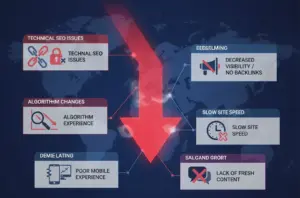The rapid or gradual loss of traffic on a website is something that fills every marketer, business owner, and content producer with anxiety. It can be like its life support to see those analytics charts trend down. It is very important to know before the panic sets in that a decline in traffic is the symptom, not the accident itself. The most important and key step to recovery is the diagnosis of the root cause.
Traffic declines may be caused by an infinite variety of factors, including technical hiccups that remain invisible and significant changes in the search habits of people on the Internet. We are going to divide the major reasons into four major ones: Technical Issues, Search Engine Algorithm Updates, Content and Competitive Challenges, and External Factors.

1. Unseen Subversive: Technological Problems.
Your website is a machine and in case the main building blocks malfunction, both the search engines and the users will access your site easily. The most pressing cause of a traffic drop can be technical issues.
- Crawling and Indexing Errors: Crawlers are search engine tools which search and index your web pages. Unless they can do it, your pages will not be found in search results. Common culprits include:
- Robots.txt Blocking: Sometimes, an innocent command in your robots.txt file may block search engines from important parts of your site such as the whole of your site.
- Bad Redirects: When there is a sequence of redirects (e.g. a 301 redirect that points to a 301 redirect) a crawler may get lost, and it will remove the page.
- Indexation Blocks: A (noindex) meta tag could have been included on key pages by mistake to inform the search engines to disregard them.
- Crawl Budget Waste: An older number of low-value URLs (such as faceted navigation in e-commerce) can eat up your crawl budget, i.e. search engines will never get around to indexing your valuable pages.
- Speed and Usability: As of now, not only are speed and usability nice-to-haves, but they are also direct ranking criteria.
- Poor loading times: Waiting an additional one second would have a severe influence on conversions and bounce rates. Core Web Vitals at Google measures the loading performance, the interactive performance, and the visual stability specifically. The failure of these metrics can result in low rankings.
- Ineffective Mobile Experience: A site not created as a mobile-friendly site is at a great disadvantage since most web traffic is through mobile devices. The consumers will exit your site fast, and Google will notice that your site does not work well on a phone.
- Security Problems: A website whose URL does not start with an “s” is a big warning sign. Google can specifically notify the user that your site is not secure or dangerous and this will destroy your traffic.
2. The Rule Changes: Search Engine Algorithm Changes.
Thousands of updates are made to the search algorithm by Google every year. The vast majority of them are minor, although it periodically releases a so-called broad core update, which can radically change the search environment. The existence of a traffic downturn that is correlated with a known update date is a good indication.

- Useful Content Change: This is considered to be the most important change in the past years. Google is also rewarding content that is designed to cater to human beings rather than to search engines in an orderly manner. Unless your content is meant to be helpful (not keyword-stuffed, shallow, or overly SEO-optimized) but rather helpful in the actual sense of that word, it is not going to gain any ground. The system will bring up the content that is written by the professionals who will have first-hand experience and demonstrate the depth of knowledge.
- Core Updates: These are generic updates that are meant to enhance the overall evaluation of Google in terms of content quality. They do not focus on niches; instead they re-analyze all of the content through a sophisticated system of requirements of Expertise, Authoritativeness and Trustworthiness (E-A-T). A decline following an update of its core implies that Google has determined that other sites are more reliable and useful to your target queries than theirs.
- Page Experience Update: The update recognized the significance of user experience and, in addition to the previously used mobile friendliness, safe-browsing, and HTTPS, integrated the Core Web Vitals. The bad user experience of technology can now directly damage your rankings.
3. The Competitive Landscape and Contents.
Not all the time is the issue of your site plumbing or a Google update it is what you are selling and who you are competing with.
- Content Decay: The internet is not a mausoleum; it is a living ecosystem. The article you published in 2018 on the topic of Social Media Trends which was previously ranked as one of the best is probably outdated. Information loses its relevance, accuracy, and completeness with the course of time. It is a gradual process of rankings and traffic that decreases with this content decay as new, more recent resources are preferred both by searchers (and Google).
- Loss of Backlinks: Backlinks are the votes of confidence of other websites. In case you lose good-quality backlinks (a site that was linking to you deletes its resource page, or you have outdated material on your site), your perceived authority on the site can decrease, and thus you will be ranked lower.
- Higher Competition: The online world is active. Your competitors are not standing still. They may be:
- Producing better quality and more comprehensive content.
- Development of a better backlink profile.
- Providing a more user-friendly experience.
- Just spending more money than you on paid advertising, which has the potential to drain away potential organic traffic.
- Change in User Intention: Sometimes, users change their intentions when they continue searching for a keyword. To illustrate, a search query of “best laptops” would have been fulfilled in the past with a blog article, whereas in the present Google will favor category pages of e-commerce or video reviews. The rankings of your pages will decrease in case your page ceases to align with the prevailing user intent.
4. Outside Things You Have No Control Over.
You should not blame yourself when there is a traffic drop. The wider market and channel shifts can be a huge influence.
- Seasonality: Most businesses possess peaks and troughs which are natural. The traffic of a tax accountant will reduce immensely in July and a holiday decor site will experience a huge decline in January. You need to trace your traffic on a year-on-year basis (July 2024 versus July 2023) as opposed to monthly to consider the seasonal factor.
- Alterations in Social Media Strategy/Algorithm: In case a large share of your traffic was generated through a social site such as Facebook, Pinterest, or Twitter and then you modified your posting pattern or the algorithm used by that platform was altered, your referral traffic might nosedive.
- Brand Awareness and Paid Campaigns: Brand search and direct traffic could decrease with the decrease of offline marketing (TV, radio, print) or the halting of a successful Paid Search (PPC) campaign, which makes it seem like your own organic traffic is declining.
How to Diagnose Your Traffic Drop: Action Plan.
Determine the Timeline: Was the fall sharp (technical problem or new algorithm) or slow (decay of content or competition)?
- Apply Your Tools: Get Your Wizardry: Explore Google Analytics and Google Search Console (GSC). GSC is especially crucial, as it is necessary to check the indexing errors, impressions and clicks decline of certain keywords, and any manual activities.
- Look for Algorithm Updates: Use industry sources such as Search Engine Land or SEO blogs to know whether a significant update was made during the period of your traffic decline.
- Content audit: Find your best-performing pages that have lost their traffic. Are they outdated? Is it possible to update and improve them?
- Examine the Competition: Find your main keywords. Who is ranking above you now? What are they doing better?
The decline in traffic on the site is an indicator and not a pronouncement. Investigating these main areas, namely, technical health, adherence to the algorithms, quality of the content, and the external environment methodically, you can be in a state of panic and a state of power. The recovery process starts with a definite identification of the problem.
Conclusion
A decrease in online traffic is not a sentence to death but rather a symptom. Determining if the cause is technical, algorithmic, competitive, or external, you would be able to develop a targeted recovery strategy. Sites with a consistent audit, update and optimization of the content and experience tend to recover better than ever.
FAQs
Q. What is the turn around time of a traffic drop?
Recovery time varies. It will take days to repair a technical problem and weeks or months to recover after an algorithm strike, particularly when content quality has to be replenished.
Q. What can I know to make sure that Google does not punish my site?
Google Search Console—Manual Actions. When none are shown, then it is probably an algorithmic re-ranking, rather than a penalty.
Q. Is it true that old content is damaging to the rankings?
Yes. Google focuses on original, precise and topical content. Older posts can be refreshed and made to perform again.
Q. Is it good to remove poor-performing pages?
Only when they are not trafficked do they not have backlinks or chances of improvement. In many cases, it is better to refresh and merge similar ineffective pages rather than to delete them.
Q. What do you think is the most effective way to track traffic changes?
Monitor behavior and conversion using Google Analytics, and impressions, clicks and ranking trends using Google Search Console. The competitors can be observed with the help of such tools as Ahrefs or SEMrush.


